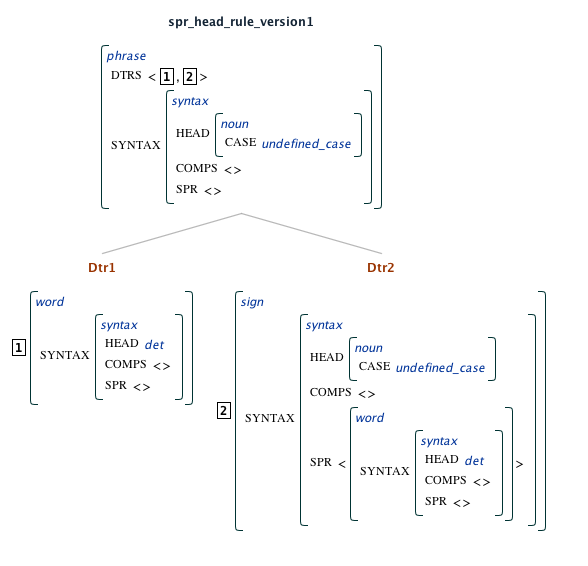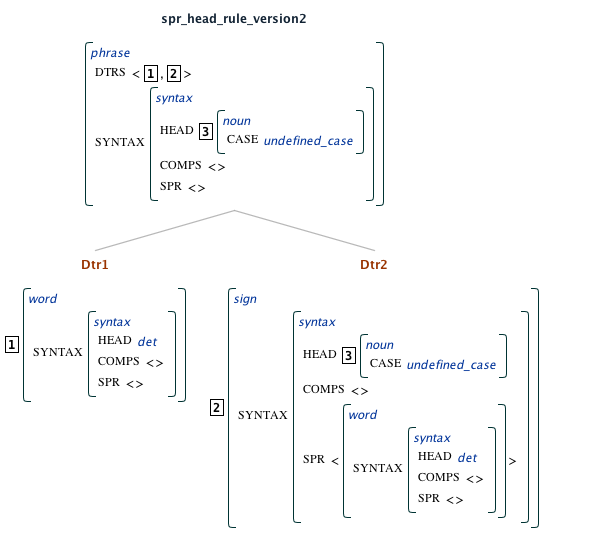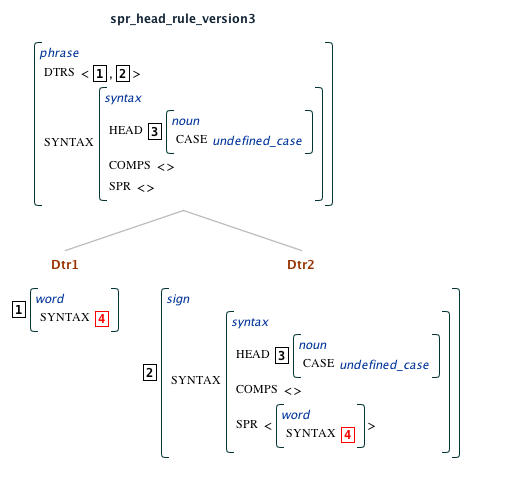Grammar Writing: Week 11
Auxiliaries, Identity and the Head-Complement Rule
So far, all our sentences just have a single finite main verb in them. But, of course English also has sentences with one or more auxiliary verbs and a main verb:
1. Lilly is dancing
2. Lilly has danced
3. Lilly will dance
4. Lilly will be dancing
5. Lilly will have danced
6. Lilly will have been dancing
Exercise 1
While the sentences above are grammatical, the ones below are ungrammatical:
7. *Lilly is dance
8. *Lilly has dancing
9. *Lilly will danced
Fill in the blanks below:
a. The forms of the progressive auxiliary be select a VP-complement whose VFORM value is: _____ .
b. The forms of the progressive auxiliary have select a VP-complement whose VFORM value is: _____ .
c. The forms of the progressive auxiliary will select a VP-complement whose VFORM value is: _____ .
Exercise 2
Add lexical entries to your grammar which license all the sentences (1)-(6), but disallow (7)-(9).
Make the following assumptions:
- All auxiliaries belong to part of speech verb.
- Some auxiliaries have different inflectional forms (e.g. be, is, been).
- The modal auxiliaries (e.g. must, can) and will only have finite forms.
- If an auxiliary has more than one form, then you need a lexical entry for each different form!
- Every auxiliary selects a VP-complement with a particular VFORM value (see above).
NOTE: in order to complete this excercise, you do NOT need to add any syntactic rules. All you need are the lexical entries of the auxiliaries!
CAUTION: make sure that your grammar does NOT license any of the following sentences:
8.* Lilly is liking.
9. *Lilly has liked.
10. *Lilly will like.
Hint: the auxiliaries should make sure that their complement is itself COMPS-complete.
Specifiers
Most of the NPs we have modelled so far were either names or pronouns. But like VPs, APs, PPs, and Ss, NPs can of course also consist of more than one word:
11. the cat
12. a cat
These NPs all consist of a determiner D and a noun. Our grammar up to this point does not allow us to license such multi-word NPs. But, it is easy to do so. For that purpose, we will postulate a new grammatical function, namely the SPECIFIER. We will assume that the words cat and cats in (11)-(12) are unspecific as to how many (of the) cats the speaker wishes to identify (one vs. more than one) and whether a definite cat is referred about or not (the vs a). The function of the determiner is to specify this kind of information. For this reason, we assume that the NPs in (11)-(12) have the form of SPECIFIER + HEAD.
Exercise 3 (due date: Sunday, 8 p.m. on January 14th 2018)
- Add the part of speech det to the same place in the type hierarchy where the other parts of speech are already defined.
- Add the feature SPR with value list to the same place in the type hierarchy where the feature COMPS is already defined.
- Add lexical entries for the determiners the, a, and those to the lexicon. Determines do not need any complements and any specifiers.
- Delete the old lexical entry for the word cat.
- Add a new lexical entry for cat as follows: there word takes no complements but does take one D as specifier.
Upload your grammar to make sure that the structure of the determiners are compatible with what the single member of the SPR list of the word cat.
Exercise 4 (due date: Sunday, 8 p.m. on January 14th 2018)
If everything went well, then at this point your grammar contains the noun cat and the three determiners the, a, and those in such a form that the determiners make possible specifiers of cat. All that is missing for the grammar to license NPs of the form SPR + HEAD is a new phrase structure for NPs. Like the VP-rule, the NP-rule will combine a HEAD daughter with a non-head daughter, but there are 2 differences: a. this time the second daughter will be a specifier rather than a complement; (b) the order of the two daughters is reversed: the first daughter is the specifier and the second one the head daughter!
With these preparations, write a new phrase structure rule, the head_specifier_rule, as follows:
- The mother is a phrase with empty COMPS and SPR lists.
- The second daughter is a noun word with empty COMPS and <D> as a SPR.
- The first daughter is a determiner word.
- The HEAD value of the mother is identical to that of the second daughter.
The following three versions should all work:
Implement one of them but note the differences in the elements that share identical properties.
Modifiers
Our grammar already can handle a lot of features of English syntax:
- Main verbs of different inflectional types
- Subjects and complements
- Auxiliaries
- Prepositional phrases
- Simple noun phrases
One important grammatical function is still missing, however, namely modifiers. Modifiers (also called adjuncts) differ from arguments in two important respects:
- Arguments (= subjects and complements) are selected by a head and are usually obligatory.
- Adjuncts in turn select the head and thus are always optional.
Adjectival modifiers
The most typical modifiers of nouns are adjectives:
(1) the student
(2) the clever student
Note that adjectives cannot modify verbs:
(3) Lilly ran
(4) * Lilly clever ran.
Note that the adjectival modifier has to appear between the specifier and the head:
(5) *clever the student
Also note that only common nouns (i.e. the ones that refer to kinds of things) can be modified, nouns that refer to individuals cannot:
(6) *clever she
Exercise
We want to extend our grammar so that it predicts the grammaticality judgments of the expressions (1)-(6) above. To achieve this, we need lexical entries for adjectives and a new grammar rule.
A. Add a lexical entry for the word clever to the grammar. Give it the empty list of specifiers and complements.
B. Add a new phrase structure rule Adjective-Noun-Phrase with the following properties:
- The first daughter is an adjective word.
- The second daughter is a noun sign with empty COMPS.
- The mother is a phrase with empty COMPS.
- The HEAD value of the mother is identical to that of the second daughter.
The way it is written, the rule will overgenerate (i.e. allow expressions that are ungrammatical). For instance, it will wrongly license the expressions (5) and (6) above. However, the problem is easily solved. Think about the grammatical difference between the specifier lists of common nouns on the one hand and those of names and pronouns on the other hand. Then ask yourself the following questions:
- Adjectives can modify common nouns but not names and pronouns: what value of the SPR list of the head daughter in the Adjective-Noun-Phrase will predict this state of affairs.
- What value should the SPR list of the mother have in order to allow a determiner to be added in front of a Adjective-Noun-Phrase?
Exercise
What do you have to add to the grammar for it to license the strings below:
(7) the clever young student
(8) the clever tall young student
How many adjectives can a noun phrase have in principle in this grammar?
Prepositional Phrase Modifiers
Many verbs can be modified by Prepositional Phrases:
(9) Lilly arrived.
(10) Lilly arrived on Monday.
Exercise
It is very easy to extend our grammar to license examples like (10). Do the following:
A. Add the word on to the lexicon. It is a regular preposition (prepositions do not take specifiers).
B. Add the word Monday to the lexicon. Treat the word like a proper name.
C. Add a new rule to the grammar, as follows:
- The first daughter is a verb sign with empty COMPS.
- The second daughter is a PP.
- The mother is a phrase with empty COMPS.
- The HEAD value of the mother is identical to that of the first daughter.
Exercise
Note that PP modifiers can also be added after a noun:
(11) The party.
(12) The party on Monday.
Add a rule to the grammar which licenses example (12). The rule will be almost identical to the rule in the previous exercise.
Exercise
Add the lexical entry for the adjective rousing to the grammar and nothing else. Does your grammar now license the sentence below:
(13) The rousing party on Monday
If your grammar licenses the sentence, how many trees to you get? Explain your answer!
Agreement
In case you are working already on agreement features, please make sure to spell out numbers in type names, i.e. "non_3s" should be "nonthirdsingular", and so on.
Navigation:


